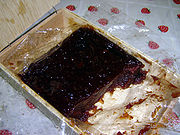
Goiabada
Encyclopedia

Portuguese language
Portuguese is a Romance language that arose in the medieval Kingdom of Galicia, nowadays Galicia and Northern Portugal. The southern part of the Kingdom of Galicia became independent as the County of Portugal in 1095...
-speaking countries of the world, dating back to the colonial days in Brazil
Brazil
Brazil , officially the Federative Republic of Brazil , is the largest country in South America. It is the world's fifth largest country, both by geographical area and by population with over 192 million people...
, where guavas were used as a substitute for the quinces used to make marmelada (Quince cheese
Quince cheese
Quince cheese is a sweet, thick, quince jelly or quince candy.The recipe is probably of ancient origin; the Roman cookbook of Apicius, a collection of Roman cookery recipes compiled in the late 4th or early 5th century AD, gives recipes for stewing quince with honey.Historically marmalade was made...
). Abundance of sugar and slave labour were crucial for its confection, in large cauldrons cooking over a slow fire. It is a conserve made of guava
Guava
Guavas are plants in the myrtle family genus Psidium , which contains about 100 species of tropical shrubs and small trees. They are native to Mexico, Central America, and northern South America...
, sugar
Sugar
Sugar is a class of edible crystalline carbohydrates, mainly sucrose, lactose, and fructose, characterized by a sweet flavor.Sucrose in its refined form primarily comes from sugar cane and sugar beet...
and water
Water
Water is a chemical substance with the chemical formula H2O. A water molecule contains one oxygen and two hydrogen atoms connected by covalent bonds. Water is a liquid at ambient conditions, but it often co-exists on Earth with its solid state, ice, and gaseous state . Water also exists in a...
. It is still commonly made at home for family use or by home industry outlets (traditional recipes) or as processed food.
It is known as guava paste or guava cheese throughout the English
English language
English is a West Germanic language that arose in the Anglo-Saxon kingdoms of England and spread into what was to become south-east Scotland under the influence of the Anglian medieval kingdom of Northumbria...
-speaking Americas, especially the Caribbean
Caribbean
The Caribbean is a crescent-shaped group of islands more than 2,000 miles long separating the Gulf of Mexico and the Caribbean Sea, to the west and south, from the Atlantic Ocean, to the east and north...
and pasta de guayaba in Spanish speaking Americas. It is commercially available, most often packaged in flat metal cans.
In Brazil, goiabada is usually eaten with Minas cheese
Minas cheese
Minas cheese is a type of cheese that has been traditionally produced in the Brazilian state of Minas Gerais. It comes in three varieties, named Frescal , Meia-cura and Curado...
. This combination is referred to as "Romeo and Juliet
Romeo and Juliet
Romeo and Juliet is a tragedy written early in the career of playwright William Shakespeare about two young star-crossed lovers whose deaths ultimately unite their feuding families. It was among Shakespeare's most popular archetypal stories of young, teenage lovers.Romeo and Juliet belongs to a...
", a custom attributed to a Bulgarian
Bulgarian customs
* Martenitsa, all of March* Nestinari* Kukeri* Koleda , Koledari* Velikden * Name Days* International Mother's Day, March 8* Independence Day, March 3* Sveti, Sveti Kiril i Metodii, May 24-External links:...
influence. It is particularly popular spread on toast at breakfast, or served hot with cheese inside an empada pastry, as a kind of miniature pie. In Portugal
Portugal
Portugal , officially the Portuguese Republic is a country situated in southwestern Europe on the Iberian Peninsula. Portugal is the westernmost country of Europe, and is bordered by the Atlantic Ocean to the West and South and by Spain to the North and East. The Atlantic archipelagos of the...
it is used as the filling of the popular "bolo de rosas" (rose cake) in which a layer of pastry is covered with goiabada, then rolled and cuts into pieces that resemble roses. This same cake is called "rocambole" in Brazil and also uses a layer of pastry covered with goiabada, then rolled and served.
There are many different kinds of Goiabada, depending on the type of guava, and with slightly different textures and flavors. In Brazil, the most widely accepted to be the best (for "Romeo and Juliet") is called "goiabada cascão" (with fragments of guava in the paste).

